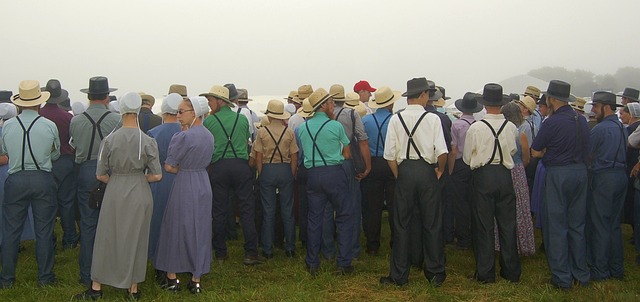The Amish, a religious group known for their traditional way of life, have chosen not to ride bicycles as a means of transportation due to their belief in simplicity and separation from modern technology.
Table of Contents
The Cultural and Religious Beliefs Surrounding Transportation in the Amish Community
Have you ever wondered why you never see an Amish person riding a bike? It’s a common sight to see them traveling in their horse-drawn buggies, but bicycles seem to be absent from their transportation options. The reason behind this lies in the cultural and religious beliefs that shape the Amish community.
The Amish are a religious group known for their simple and traditional way of life. They believe in living a life separate from the modern world, and this extends to their transportation choices. For the Amish, transportation is not just a means of getting from point A to point B; it is a reflection of their values and beliefs.
One of the main reasons why the Amish do not ride bikes is because they view them as a symbol of individualism. In the Amish community, individualism is discouraged, and the focus is on the collective rather than the individual. Bicycles, with their emphasis on personal mobility and independence, are seen as promoting individualism and are therefore not embraced by the Amish.
Another reason why the Amish do not ride bikes is because they believe in living a simple and sustainable lifestyle. Bicycles, while more environmentally friendly than cars, still require the use of non-renewable resources in their production. The Amish strive to live in harmony with nature and minimize their impact on the environment, and they believe that using horses as a mode of transportation is a more sustainable choice.
Horses are not only seen as a more sustainable option, but they also play a significant role in Amish culture and tradition. Horses are considered to be a gift from God and are highly valued in the Amish community. They are used not only for transportation but also for farming and other daily tasks. By using horses instead of bikes, the Amish are able to maintain a close connection with nature and preserve their traditional way of life.
In addition to their cultural and religious beliefs, the Amish also have practical reasons for not riding bikes. The Amish live in close-knit communities, and their transportation choices reflect this. Bicycles, with their speed and efficiency, would encourage individual members of the community to travel farther distances and potentially disrupt the close bonds that exist within the community. By using horse-drawn buggies, the Amish are able to maintain a slower pace of life and foster a sense of community and togetherness.
While the Amish may not ride bikes, it’s important to remember that their transportation choices are deeply rooted in their cultural and religious beliefs. By using horse-drawn buggies instead of bikes, the Amish are able to live a simple, sustainable, and community-focused lifestyle. So the next time you see an Amish person traveling in their buggy, remember that their choice of transportation is not just a mode of getting around, but a reflection of their values and beliefs.
The Historical Reasons Behind the Prohibition of Bicycles Among the Amish

Have you ever wondered why the Amish, known for their simple and traditional way of life, do not ride bicycles? It may seem puzzling, especially considering that bicycles are a common mode of transportation for many people around the world. However, there are historical reasons behind this prohibition that shed light on the Amish way of life.
To understand why the Amish do not ride bikes, we need to delve into their history. The Amish are a religious group that originated in Europe during the 16th century. They are known for their adherence to a strict interpretation of the Bible and their rejection of modern technology. This rejection stems from their belief in living a simple and humble life, separate from the temptations and distractions of the modern world.
In the late 19th century, when bicycles were gaining popularity, the Amish faced a dilemma. On one hand, bicycles offered a faster and more efficient mode of transportation than horse-drawn carriages. On the other hand, embracing this new technology would contradict their core values of simplicity and separation from the modern world. As a result, the Amish leadership made the decision to prohibit the use of bicycles within their communities.
This decision was not taken lightly. The Amish leadership carefully considered the potential impact of bicycles on their way of life. They recognized that bicycles could lead to a greater reliance on individualism and independence, which went against their emphasis on community and interdependence. Bicycles could also create a desire for speed and efficiency, which could distract from the Amish focus on patience and mindfulness.
Furthermore, the Amish leadership saw bicycles as a gateway to other forms of modern technology. They believed that allowing bicycles would open the door to a slippery slope of technological advancements that would ultimately erode their traditional way of life. By drawing a clear line against bicycles, the Amish sought to maintain their distinct identity and preserve their values for future generations.
It is important to note that the prohibition of bicycles among the Amish is not a universal rule. Different Amish communities may have varying levels of strictness when it comes to technology. Some communities may allow bicycles for certain purposes, such as work or emergencies, while others may completely prohibit them. The decision ultimately rests with the local church leadership, who carefully consider the potential impact on their community.
In conclusion, the historical reasons behind the prohibition of bicycles among the Amish can be traced back to their commitment to a simple and traditional way of life. The Amish leadership made the decision to prohibit bicycles in order to preserve their values of community, interdependence, and separation from the modern world. While this prohibition may seem puzzling to outsiders, it is an integral part of the Amish way of life and a testament to their commitment to their beliefs.
The Impact of Modern Technology on Amish Lifestyle and Transportation Choices
Have you ever wondered why you never see an Amish person riding a bike? It’s a common sight to see them traveling in their horse-drawn buggies, but bicycles seem to be absent from their transportation choices. The reason behind this lies in the impact of modern technology on the Amish lifestyle.
The Amish community is known for its commitment to a simple and traditional way of life. They strive to live separate from the modern world and its conveniences. This includes avoiding the use of electricity, cars, and other modern technologies. Instead, they rely on more traditional methods of transportation, such as horse-drawn buggies.
One of the main reasons why the Amish do not ride bikes is because they view them as a form of modern technology. While bicycles may seem simple and low-tech to most people, the Amish see them as a step towards the modern world that they are trying to avoid. They believe that using bicycles would lead to a slippery slope of dependence on technology, which goes against their core values.
Another reason why the Amish do not ride bikes is because they prioritize community and family over individualism. Bicycles are often associated with individual freedom and independence. They allow people to travel quickly and easily on their own, without relying on others. However, the Amish value community and believe in the importance of relying on one another. By traveling in horse-drawn buggies, they are able to spend time together as a family and as a community. It also allows them to slow down and appreciate the world around them, rather than rushing from one place to another.
In addition to their philosophical reasons for not riding bikes, there are also practical considerations. The Amish live in rural areas with unpaved roads and rough terrain. Bicycles are not well-suited for these conditions and would require constant maintenance and repairs. Horse-drawn buggies, on the other hand, are better equipped to handle the challenges of rural living. They can navigate rough roads and carry heavy loads, making them a more practical choice for the Amish.
While the Amish may not ride bikes, it’s important to remember that they are not completely opposed to all forms of modern technology. They do make use of some modern conveniences, such as gas-powered generators and power tools. However, they carefully consider each technology and its impact on their way of life before deciding whether or not to adopt it.
In conclusion, the Amish do not ride bikes because they view them as a form of modern technology that goes against their commitment to a simple and traditional way of life. They prioritize community and family over individualism, and traveling in horse-drawn buggies allows them to spend time together and appreciate their surroundings. Additionally, the practical considerations of living in rural areas with rough terrain make bicycles an impractical choice for the Amish. While they may not ride bikes, the Amish carefully consider the impact of modern technology on their lifestyle and make choices that align with their values.
Exploring Alternative Modes of Transportation in the Amish Community
Have you ever wondered why you never see an Amish person riding a bike? It’s a common sight to see them traveling in their horse-drawn buggies, but bicycles seem to be absent from their transportation options. In this article, we will explore the reasons behind this and delve into the alternative modes of transportation that the Amish community embraces.
One of the main reasons why the Amish do not ride bikes is because they believe it goes against their religious principles. The Amish value simplicity and humility, and they see bicycles as a form of self-indulgence and pride. Riding a bike could potentially lead to a sense of independence and individualism, which goes against their communal way of life. By relying on horse-drawn buggies, the Amish are able to maintain their sense of community and interdependence.
Another reason why the Amish do not ride bikes is because they prioritize safety. Bicycles can be fast and unpredictable, and accidents can happen easily. The Amish are known for their cautious approach to life, and they prefer to avoid any unnecessary risks. Horse-drawn buggies, on the other hand, are slower and more predictable, making them a safer mode of transportation for the Amish.
Despite not riding bikes, the Amish community has embraced alternative modes of transportation that align with their values. One such mode is the use of scooters. These scooters are not your typical motorized scooters that you might see in a city. Instead, they are foot-powered scooters that resemble a cross between a bike and a skateboard. They allow the Amish to travel faster than walking, but still maintain a sense of simplicity and humility.
In addition to scooters, the Amish also use rollerblades as a means of transportation. Rollerblades provide a fun and efficient way to get around, while still adhering to the Amish principles of simplicity and community. It’s not uncommon to see Amish children and teenagers gliding down the road on their rollerblades, enjoying the freedom and excitement that comes with this mode of transportation.
Of course, the most iconic mode of transportation in the Amish community is the horse-drawn buggy. These buggies are not only a means of getting from point A to point B, but they also serve as a symbol of the Amish way of life. The horse-drawn buggy represents their commitment to simplicity, humility, and community. It’s a reminder that they are part of something bigger than themselves and that they rely on each other for support and companionship.
In conclusion, the Amish do not ride bikes because they believe it goes against their religious principles and prioritizes safety. Instead, they have embraced alternative modes of transportation such as scooters, rollerblades, and the iconic horse-drawn buggy. These modes of transportation allow them to maintain their sense of community, simplicity, and humility while still getting around efficiently. So, the next time you see an Amish person traveling in their horse-drawn buggy, remember that it’s not just a mode of transportation, but a symbol of their way of life.
Conclusion
The Amish do not ride bikes due to their belief in simplicity, humility, and separation from modern technology.
For licensing reasons, we must provide the following notice: This content was created in part with the help of an AI.


